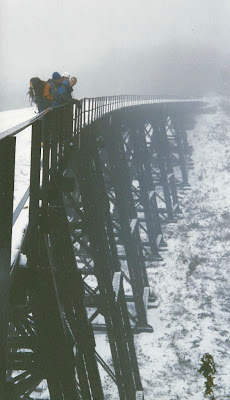“That’s only 47, there are three missing,” said Anna. We were
riding around in the cool shadow of the rising sun, counting horses at the 7D
Ranch in Wyoming. We’d just finished a patrol of the area surrounding the gate
of a mountainside pasture, where the majority of the 50-horse herd grazed,
nuzzled each other, swatted their tails, and watched us lazily.
We’d given ourselves 2 hours to wrangle the horses back to the
ranch before breakfast. Anna, a 7D Ranch hand, knew immediately which three
were missing, and that they are part of their own social group, so we knew if
we found one, the other two would be close by. We chose a direction and headed
off for the ultimate game of hide-and-seek.
I was fortunate enough to grow up riding horses. The ones I
knew had lives very different from that of a ranch herd. At English style horse
farms in Ohio, each animal has a stall that they live most of their lives in,
with maybe an hour on pasture per day being social and an hour being pampered and ridden. Our
attention was on grooming, stall cleaning, feed and supplement decisions, and
horse show schedules. Sixteen year old me would have been appalled that ranch
horses would be left out overnight, every night with hazards like mountain scree
slopes, fast moving rivers, and even grizzly bears, and that they’d be moved as
herds, with the potential to step in badger holes or hurt each other as they
make their way from pasture to ranch every morning, and from ranch to pasture
every night.
Now, as an almost-middle-aged ranch guest on a vacation
with the in-laws, I guess I see things differently. Growing up, I was one of
those straight-A students who would do anything to please anyone. I am earnest
and introverted by nature, which makes it hard to know what ‘fun’ is even
supposed to be or how to have it. Fast-forward a few decades and it’s still the
same old me, craving to be different while needing to be the same. I tried sneaking out of the house and smoking cigarettes and
piercing my body. Then it was about going climbing and avoiding a career and any
other responsibilities. Now, as I settle into a real job, a house and marriage,
we spend far more time working, training, cooking, cleaning and hosting than I
care to admit. I sometimes feel too scarily like those horses in stalls;
hygienic, regimented, predictable and comfortable.
The balance I now think I crave is to do
work I feel good about, yet still take risks and be impulsive, even as my frontal lobe matures and tells me not to. So I’ve promised to forgive myself when the garden gets
weedy, when a friendship goes untended, when a niece or nephew’s birthday party
is missed or when a career opportunity gets lost, because I know that my instincts have
me tending to each of these things most of the time. I have to actually work much harder these days to challenge my
own nature and to more often be the missing herd animal, off with my friends finding the best grass and forgetting everything else.
As Anna and I continued our hunt that morning, transitioning
out of the shadow and into the soft, warm morning light, we saw, way off in the
distance, in a field of the freshest, greenest grass, within the fence line of
the neighbor’s property, three horses. Anna noticed that the gate was open: they
were our three missing ones, grazing where they weren’t supposed to be. We
laughed as we trotted down to them, and pretend-scolded them as we wrangled
them back towards the main herd.















